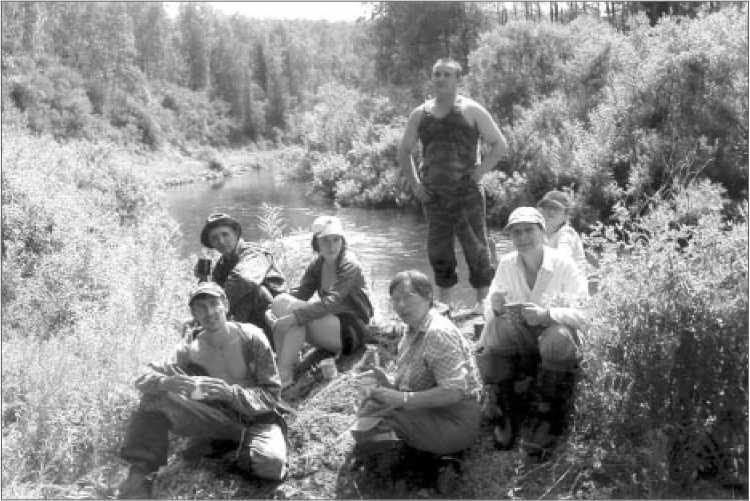The silurian of Siberia.S (Salair region)
Бесплатный доступ
Короткий адрес: https://sciup.org/149128899
IDR: 149128899
Текст статьи The silurian of Siberia.S (Salair region)
In July 2004, an NSF-AAAS grant designed to support women’s international collaborations in science enabled me to investigate with long-time geo-colleague, Dr. Anna Antoshkina, a new field area in Siberia. We explored Silurian deposits ~425 million years old west of the city of Novokuznetsk in one of Russia’s most important coal-producing areas. Our aim was to determine if the rocks and fossils are similar to those we’ve examined together in southeastern Alaska and the Ural Mountains, Russia.
Anticline
Documenting important similarities and differences in Alaskan, Russian, and — most recently — Mongolian rocks will allow us to test hypotheses about the ancient Uralian Seaway. This subtropical marine “highway” existed more than 400 million years ago approximately where the Arctic Ocean is located today, except the entire area was shifted to the south and positioned within 10° of the paleo-equa-tor. Evidence from Alaska and the Urals reveals the Uralian Seaway was an important marine corridor for several million years. It enabled tropical reef-dwelling species to migrate between North America to the west, Northern Europe (Baltica) and possibly central Asia (Mongolia) to the east, and Siberia to the north.
Samples we’ve collected should allow us to begin addressing questions about: (1) the composition and paleoecology of microbial-sponge communities that built offshore, barrier reefs in the mid-late Silurian; (2) whether terrigenous run-off from the Caledonide Mountains fueled nutrient overloading and subsequent microbial “blooms” in the reefs; (3) the environmental circumstances that terminated reef growth in the Late Silurian; and (4) if closure of the Uralian Seaway during late-stage Caledonide mountain-building activity was an underlying cause of the mass extinction that unfolded at the end of the Silurian period. Similar processes could be taking place today in the Mediterranean Sea.
Our expedition to the southeastern part of Siberia’s Salair region took place mainly along the Tom’-Chumysh River. Travel by boat and under- standing the regional geology was greatly facilitated by the dedicated efforts of Anna Antoshkina (Russian Academy of
Pentamerid mound
Sciences and Institute of Geology, Syktyvkar); Yaroslav Gytak (Chief, Kuzbass State Pedagogical Academy in Novokuznetsk); Galina Bagmet (fossil algae specialist at Kuzbass State Pedagogical Academy); Vasilij Savitskij (PhD candidate at Kuzbass State); and students Kostya, Tanya, and Zoya.
The dense foliage of Siberia’s taiga presented challenges in mapping the lo-
Anna, Galina, Yaroslav at pentamerid mound

cal geology, which was last surveyed in 1967. Careful reconnaissance revealed limestone of the Potбpovka Formation exposed in a massive outcrop above the Tom’-Chumysh River. Forest clearing preceded detailed study, which revealed the presence of abundant brachiopod and coral fossils concentrated together in a small mound, or biostrome. Zoya and Tanya collected data on the 60 individual brachiopods to determine their taxonomy and paleoecology, as revealed by their size, orientation, and the enclosing matrix. In the rocks we examined, no evidence exists of reefs similar to those we described from the Northern Urals or that Anna and her colleagues examined in northern Salair. We’ll be interested to hear what Anna’s students conclude about this interesting enigma.
It took 2.5 days to paddle our way down the Tom’-Chumysh River to the Chumysh River and an additional 2 days before we were able to haul out at the village of Kostenkovo. The strength of Siberia’s summer sun (and of its buzzing hordes of mosquitoes) while floating on the slow river currents made for a peaceful, but arduous journey (~ 50+ miles) through a vast roadless and largely uninhabited region.
Anna, her Russian colleagues, and I

Group picture above river
share ongoing interests in understanding more about the geologic relationship that may have existed between rocks exposed in northern North America (Alaska), Northern Europe (Ural Mountains), Siberia (Salair), and Asia (Mongolia) — continents that were isolated from each other by ocean basins hundreds of millions of years ago. Future research should show if the fossils we collected confirm that tectonic forces were severe enough to produce dramatic evolutionary changes along the Uralian Seaway. This evidence may explain, in part, what caused the mass extinction of oceanic life that brought the Silurian period to a catastrophic close.
Constance M. Soja*Department of Geology*Colgate University*Hamilton, NY 13346


Гравюра О. Велегжанинова


